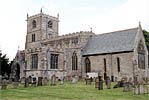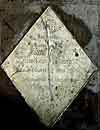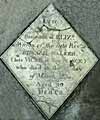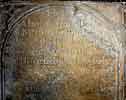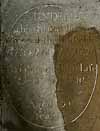For this church:    |
|
| TO THE GLORY OF GOD AND IN LOVING MEMORY OF ARCHIBALD CAMPBELL DENNISTOUN WHO DIED AT CARLTON HOUSE CARLTON ON TRENT SEPT. 22ND 1882 AGED 82 YEARS AND OF MARY DENNISTOUN HIS WIFE WHO DIED AT FLORENCE OCT. 18TH 1877 AGED 72 YEARS |
4On east wall at the entrance into the south transept, a convex marble wall tablet with moulded base and curved head (93cm x 113cm, 260cm above floor level), probably originally erected on a pillar:
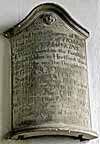
| Erected to the Memory of Willm. Hawkins the Son of THOMAS and ANN HAWKINS Of Wandonend in the Parish of King’s Waddin in Hertford Shire His mother was the Daughter to MR EDMUND STURTEVANT of Pallace Hall and he was Nephew to ye Present MR THOMAS STURTEVANT of Pallace Hall he Departed this Life Janry the 14th In the Year of our Lord 1755 In the 31st Year of his Age |
At the top of the memorial there is the face of a winged cherub as decoration.
5On east wall of south transept, as Monument 4, a convex marble wall tablet with moulded base and curved head (62cm x 100cm, 260cm above floor level), inscribed:
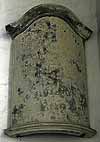
Near |
The date 1772 has been corrected from 1782. The memorial is signed in the bottom righthand corner: J. Wallis, Newark. A slightly different version of this inscription is described by William Dickenson, when the monument was ‘On a pillar in the body of the church’.
6In the corner of the west wall of the south transept, a raised white marble tablet (76cm x 56cm), with a ruled black surround, on a black base (93cm x 74cm, 223cm above floor level), inscribed:
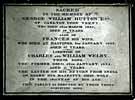
SACRED  ALSO OF  LIKEWISE OF CHARLES AND WILLIAM WELBY,  THIS TABLET IS ERECTED BY THEIR THREE |
[Signed under bottom righthand corner: Nicholson and Wood, Newark]
7In centre of west wall of south transept, an elaborate now-largely illegible stone and slate armorial monument (241cm x 120cm, 235cm above floor level), inscribed in small capitals, of which Dickenson provides a full transcription (when it was positioned in the chancel):

Reader what erst; Let fall thy Christal teare,  Eternitati Sacri |
A translation, adapted from Guy Hemingway may be offered:
In eternal and sacred memory. Here lies Elizabeth, daughter of William Ayloffe, knight and baronet, of Bruttens, Essex, by Katherine, daughter and heiress of Thomas Sterne, esquire, of Melburne, Cambridgeshire. She was married to Gervase, son of Gervase Lee, formerly of Southwell, esquire, with whom she lived twice eight years and was blessed with twice eight children, equally of either sex. She died, in eager hope of the resurrection, 4th April 1629. She left the earth for the stars. Beautiful in form, farewell.
The memorial is listed as an ‘Alabaster Renaissance revival style wall monument with square foliate panel carrying central inscribed slate tablet with moulded edges, scrolled apron and flanking Ionic columns on brackets. Entablature has ogee central gable containing foliate panel with Arms and motto, and above, damaged half height effigy’. The arms are those of Ayloffe and Lee per party, with the motto on a scroll Ubi celsa magni, as well as two separate escutcheons in the upper corners displaying (1) a Lion rampant; (2) a Lion rampant, three crosslets. Similar escutcheons also occur respectively under the base of the two Ionic columns framing the monument (cf Monument 11 for similar arms). The base is further decorated with a roundel showing a Pelican in her piety.
8Below Monument 7, on west wall of south transept, a small metal tablet (26cm x 48cm, 181cm above floor-level), inscribed:
9On west wall at entrance to south transept, a lozenge-shaped, marble tablet (77cm x 85cm, 313cm above floor-level), inscribed:
10Below Monument 9, a black, rectangular black marble tablet, with concave corners (64cm x 49cm), raised on white marble base (82cm x 66cm, 229cm above floor-level), inscribed:

| Sacred to the memory of RICHARD HUTTON ESQ. who died on the 24th day of August, 1813, in the 83rd Year of his Age. Also of GEORGE HUTTON ESQ. (Brother of the above RICHARD,) and ELIZABETH his wife, the former of whom died the 13th Jany. 1814, in the 75th Year of his Age, and the latter on the 12th of July, 1802, in the 65th Year of her Age. In pace quiescant, in gloria resurgant. |
[Signed on base of tablet: R. Marshall, Newark]
11Below Monument 10, a rectangular brass square (46cm x 40cm) set on a raised marble tablet (61cm x 55cm, 147cm above floor level), with the arms Per pale, in the first on a fesse, 3 crescents, 3 lions rampant, 2 and 1; in the second between a stag’s head antlered, a star in the chief, 3 buckles below, and inscribed:
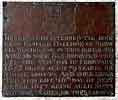
HEERE LYETH INTERRED THE BODI: |
12On north wall of the chancel, a small brass plaque (25.5cm x 20cm) on a wooden base (29.5cm x 24cm, 160cm above floor-level), inscribed:
13On the north wall of the Chancel, a small brass memorial tablet (30.5cm x 30cm, 138cm above floor-level), inscribed, within a ruled surround and with some rubrication:
Floor Tablets
The monuments in the south transept were mainly placed here during the nineteenth century restorations.
14On the floor of the south transept, a lozenge-shaped marble tablet (82cm x 102.5cm), set in a large stone slab (95cm x 186cm), commemorating the Rev Edward Walker and inscribed:
15Alongside Monument 14, another lozenge-shaped marble tablet (83cm x 103cm), set in stone slab (94cm x 186cm), inscribed:
16Alongside Monument 15, on the floor of the south transept, a virtually illegible armorial alabaster slab (92cm x 168cm), for which Dickenson gives the partial inscription:
 |
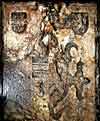 Detail Detail |
| THESSAURUS INTUS What * * * * * * visione founde Here R * is who digs this sacred grounde Shal * * * sin * * * * Cruel * * * * * * * heavenly jewel Which though * * * * his pains My diamond in clay her worth retains |
Dickenson gives the motto on a scroll beneath the shield as Thesaurus Intus. Hemingway, following him, suggests that the arms may be those described by Thoroton as:
on a monument for Gervas Lee Esq. in the Chancel’: Az., on a Fess cotised Or three Crosslets paté Or (Ayloff) and Arg. a Lion rampant Gules, and Sable a Chevron Gules between three crosslets flory Or, with a Crest (Pierie) a Demy Queen of Mauritania, party per pale Arg. & Gules, holding in her right hand a diamond ring Proper.
He further comments ‘The combination of Lee and Ayloffe suggests that the arms are those of a descendant of the Elizabeth who died in 1629’ (see Monument 7 above).
17Alongside Monument 16, a stone slab (93cm x 175cm), inscribed:
18Alongside Monument 17, on the floor of the south transept, a now-broken slab (41cm x 72cm) used to fill a space, part of a memorial for which Hemingway provides the probable inscription:
| [Here lieth the] body of ye [Rev. John T]ownsend, [who depa]rted this [life] the 19th [of February in the year of ou]r Lord [174]4 [in the ? year] of his age. |
19Adjoining the head of Monument 18, another stone slab (83cm x 100cm), inscribed within an oval surround:
Effigies
There are two recumbent tomb effigies of note:
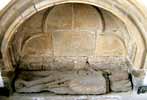 Effigy of knight Effigy of knight |
 Detail Detail |
The figure of an armed, cross-legged knight of c1330 in the south wall of the south transept, with the head detached from the body. The sandstone slab, probably of Derbyshire origin, on which the figure is carved now lies at ground level under a tomb-recess of c1280-1300; the two parts of the effigy jointly measure 190cm long x 55cm wide. From the poor, impermanent, fit it is clear that the effigy has been moved to this position in modern times, probably at the restoration of 1874-5, its original siting being unknown. Traditionally this effigy has been identified with Sir John de Lysours, lord of Willoughby by Norwell, whose turbulent career can be documented from c1279 until his murder in 1322. As the lords of Willoughby were the only armigerous family living in the parish in the early fourteenth century, this is a reasonable deduction but it rests on no documentary or heraldic evidence currently known.
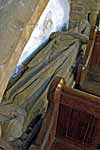 Effigy of lady Effigy of lady |
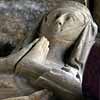 Detail Detail |
The serene figure of a lady with a wimple, her hands placed together in prayer, with her feet resting on a dog, currently lying under a raised tomb-recess of c1300 in the south wall of the south aisle. The figure in Mansfield stone is 195cm long x 48cm wide. Dated to the early 14th century by Pevsner, it may be from a few decades later, c1350 (C Brooke). As with the male effigy, there is a discordance in date between the effigy and its current position within an earlier tomb-recess, to which it may have been moved in 1874-5. No obvious identification can currently be made although it is likely that the lady belongs to the same family for whom the male figure was carved. There are also parallels with the near-contemporary tomb of a lady of the Fledburgh branch of the Lysours family that deserve further investigation. Did both the Norwell effigies once form part of a large free-standing box-tomb? It is possible that both may have been ordered together.
Grave Covers and Markers
22 Lying
on the floor in the south aisle is a large carved sandstone grave cover,
sculpted in relief, displaying a geometrical cross of fully developed round
leaf-form. It measures 186cm long x 55cm (at head) and 40cm (at foot) wide.
The shaft of the cross, which rests on a stepped base, is 40mm wide, indicative
of a late 13th or early 14th century date. It may have marked the grave of
one of the early prebendaries, possibly Mr
John Clarell (d.1295).
Lying
on the floor in the south aisle is a large carved sandstone grave cover,
sculpted in relief, displaying a geometrical cross of fully developed round
leaf-form. It measures 186cm long x 55cm (at head) and 40cm (at foot) wide.
The shaft of the cross, which rests on a stepped base, is 40mm wide, indicative
of a late 13th or early 14th century date. It may have marked the grave of
one of the early prebendaries, possibly Mr
John Clarell (d.1295).
A second sandstone grave-marker can be found outside the church.
Part of another incised sandstone slab grave marker also survives in the aumbry in the north transept where it has been re-used around 1300.
There is further information on the medieval cross slabs in the Archaeology section.
Lost Monuments
Dickenson describes a marble slab, then in the chancel floor, which now appears lost:
| Hic jacet Edwardus Lee Arm: Ob: 23: Aprilis anno aetatis 76 Annoque Domini 1712 |
He also states that ‘several persons of the family of Hutton of Carlton’ had armorial tablets in the ‘pavement of the Aisles’ but only two predating his time appear now to remain.


